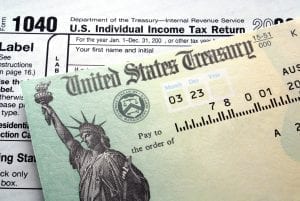Estimated Reading Time: 8 Minutes
We’re currently in the midst of tax season, and you’ve been procrastinating filing your tax return for the year. You’re definitely not alone. Just the thought of filing your taxes sounds like it’s going to be a daunting task.
Below are the most common questions about IRS Form 1040.
When are taxes due 2017?
Tuesday, April 18 is Tax Day in the United States. So if you still have yet to file your tax return it is important that you take care of it as soon as possible. If for some reason you miss the deadline it’s not the end of the world, but you do not want to deal with the repercussions. If you thought just filling out your tax return was bad, missing the deadline is a whole different beast.

If you miss the deadline it is a good idea to consider hiring a licensed professional to help. A trusted and experienced tax attorney can be difficult to find. For information about how to find a good tax attorney check out our post What you Need to Know When Seeking a Tax Lawyer & Reliable Tax Resolution Firm.
How should I notify the IRS that my address changed?
There are a few ways you can notify the IRS that your address has changed. The easiest way to do this is by using your new address when you file your tax return.
If you happen to change your address a short while after having already filed your most recent tax return, it would be most responsible to inform the IRS as soon as possible.
Even though the update will automatically occur the next time you file your taxes, the IRS may need to reach you before then.
What should I do if I made a mistake on my tax return and already filed it?
The answer depends on the mistake you made. If they are mathematical errors you do not need to worry. The IRS will catch them during the process and correct them accordingly.
File Form 1040X if you didn’t claim the correct filing status or you need to change your income, deductions, or credits. This is the Amended U.S. Individual Income Tax Return.
When you file an amended tax return there are two things to keep in mind:
1.) Make sure you include copies of any forms or schedules that you’re changing or didn’t originally include. You should only file IRS form 1040X after you’ve filed the original. Typically, in order to receive a credit or refund the form must be filed within three years after your original filing or two years after you paid the tax.
2.) You should allow the IRS around four months (16 weeks) to process the amended tax return.
Is there an age limit for claiming your child as a dependent?
In order to claim your child as a dependent, they must meet the qualifying child test or the qualifying relative test. See below.
- The qualifying child test requires your child to be younger than you and either under 19 years old or be a student. Student’s must be younger than 24 years old as of the end of the calendar year.
- There is no age limit for claiming dependency if your child is permanently and totally disabled, or if they meet the qualifying relative test.
- The qualifying relative test requires the following conditions to be met in order to classify someone as a qualified relative. They can be any age.
- They must not be a qualifying child
- They must live in the taxpayer’s household (with the exception of certain relative types, including children, siblings, nieces, nephews, in-laws, and others of this nature)
- They must have had a gross income of less than $3,650 (as of 2009), and
- They must have received more than half of their financial support for the year from the taxpayer
In addition to the above, your child must also meet three other tests for claiming dependency. These are:
1.) The dependent taxpayer test
2.) The citizen or resident test, and
3.) The joint return test
Which IRS 1040 form should I file?
There are three forms that both U.S. citizens and resident aliens use to file individual income tax returns. Form 1040EZ, 1040A, and 1040.
IRS Form 1040
If all else fails or you’re unsure if you meet the necessary conditions 1040A or 1040EZ, this the form you’ve got to fill out. This version is undoubtedly the most complex, but it’s the one that most people end up filling out.
Just as one might expect, the IRS also has a set of circumstances in which you must file form 1040. For this form, there are only four.
1.) Your taxable income is $100,000 or more
2.) You have certain types of income, such as business or farm self-employment income; unreported tips; dividends on insurance policies that exceed the total of all net premiums you paid for the contract; or income received as a partner, a shareholder in an S corporation, or a beneficiary of an estate or trust
3.) You itemize deductions or claim certain tax credits or adjustments to income, or
4.) You owe household employment taxes
IRS Form 1040EZ – Income Tax Return for Single and Joint Filers With No Dependents
This form is the easiest 1040 form to fill out, hence the “EZ” extension. There’s a catch, though. You can only use Form 1040EZ if you meet the 11 conditions listed below and if you a 1040EZ you cannot itemize deductions or claim adjustments to income or tax credits.
1.) Your filing status is single or married filing jointly
2.) You claim no dependents
3.) You don’t claim any adjustments to income
4.) You don’t claim any credits other than the earned income credit
5.) You and your spouse, if filing a joint return, were under the age of 65 on January 1st of 2017, and not blind at the end of 2016
6.) Your taxable income is less than $100,000
7.) You had only wages, salaries, tips, taxable scholarship and fellowship grants, unemployment compensation, or Alaska Permanent Fund dividends, and your taxable interest wasn’t over $1,500
8.) Your earned tips, if any, are included in boxes 5 and 7 of your Form W-2
9.) You do not owe any household employment taxes on wages you paid to a household employee
10.) You are not a debtor in a Chapter 11 bankruptcy case filed after October 16, 2005
11.) Advance payments of the premium tax credit weren’t made for you, your spouse, or any individual you enrolled in coverage for whom no one else is claiming the personal exemption
IRS Form 1040A
If you don’t meet the criteria for a 1040EZ, the 1040A may be the best option. You can use this form if you received dependent care benefits, or you owe tax on the recapture of an education credit (or alternative minimum tax). However, this form is not without its own set of conditions. To file a 1040A, make sure you meet these six criteria:
1.) Your income is only from wages, salaries, tips, interest, ordinary dividends, capital gain distributions, taxable scholarships and fellowship grants, pensions, annuities, IRAs, unemployment compensation, Alaska Permanent Fund dividends, and taxable social security or railroad retirement benefits
2.) The only adjustments to income you can claim are the IRA deduction, the student loan interest deduction, the educator expenses deduction, and the tuition and fees deduction
3.) You don’t itemize deductions
4.) Your taxable income is less than $100,000
5.) The only tax credits you can claim are the credit for child and dependent care expenses, the credit for the elderly or the disabled, education credits, the retirement savings contributions credit, the child tax credit, the additional child tax credit, the earned income credit, and/or the premium tax credit, and
6.) You didn’t have an alternative minimum tax adjustment on stock you acquired from the exercise of an incentive stock option
Moving Forward
One of the best things you can do throughout the year to avoid the struggle is to just keep your personal accounting organized. When you go through this form, write down a list of things you’ll need and create an area of your budget to display the numbers.
We’ve provided editable PDF versions of each form for your convenience. The download links are listed below. If at any time you find yourself too overwhelmed dealing with a tax return issue, or your taxes are too complex to file on your own, Boxelder Consulting is here to help. Contact us to learn more about hiring one of our experienced licensed professionals.
